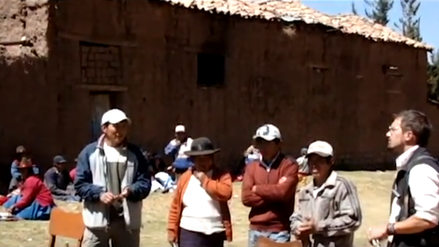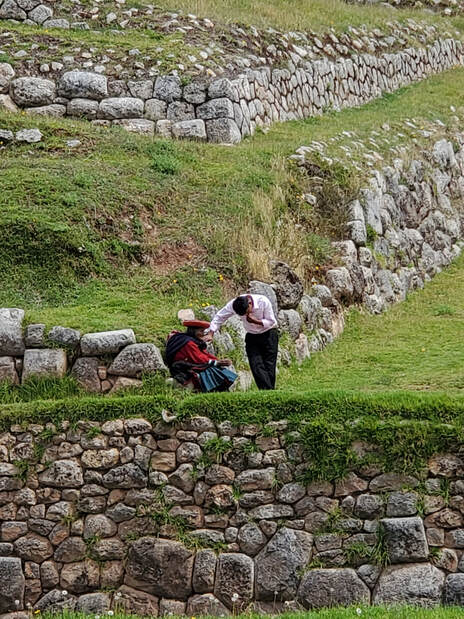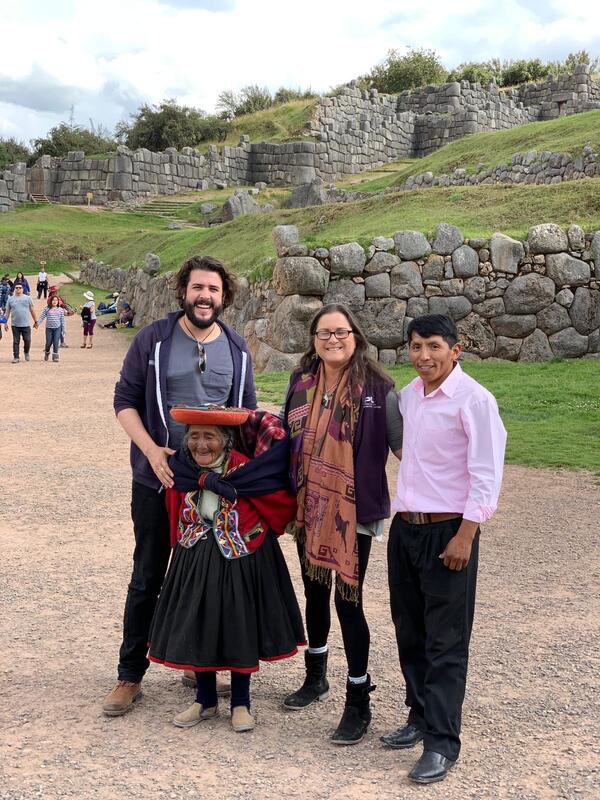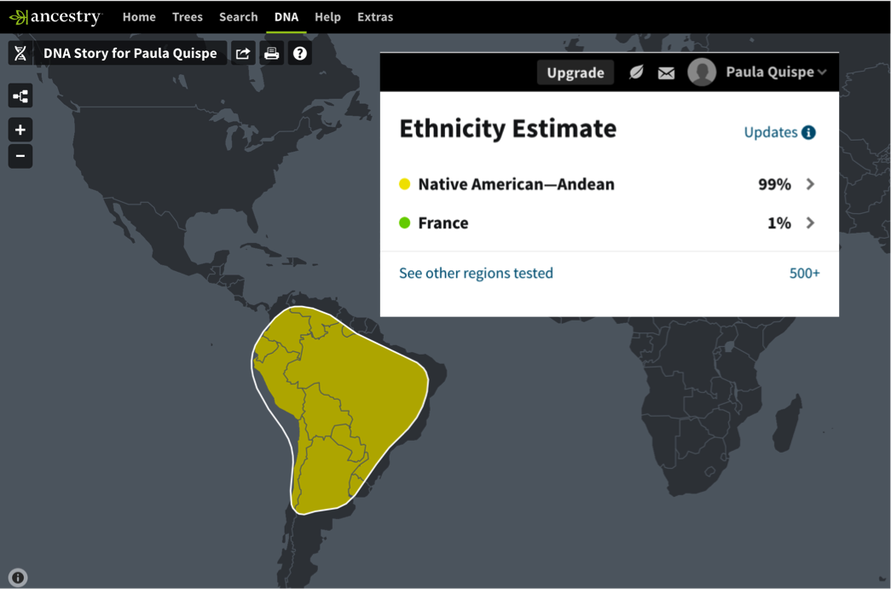My research study partner, and the amazing filmmaker on this project Dalton Gaudin, contacted me last week with the news of Paola's passing. It hit me hard...halted my busy day...caused me to tear up...and FEEL. I pulled over, stopped driving and wept over the loss of this valued elder member of the community of Fortaleza. Her departure from our beloved Mother Earth leaves a hole in the history of the Andean people. And, it leaves a hole in my soul. Paola lived 95 precious years. When we interviewed her she told us of her hard life. Hearing her then was emotional, yet rewarding to know that we were documenting the life of this elder in the Andean world. Today, I feel emotionally raw and compelled to honor this Andean woman in the best way I can...writing a blog...sharing photos of her and using the tools of a visual anthropologist to share a very human story from another culture.  I believe that Paola is one of the women sitting in the background of this photo taken in Fortaleza in 2011. I believe that Paola is one of the women sitting in the background of this photo taken in Fortaleza in 2011. In 2010, when this research project on the archaeological site of Saqsaywaman started, I met Paula Quispe Ramos during a meeting in the community of Fortaleza. I didn't know who she was. I didn't know who her family was. I just saw a weathered woman in traditional costume sitting on a log and watching a meeting about relations with the Ministry of Culture. She was regal wearing her "traditional Chinchero hat." Over the subsequent years, when we were in Peru again, I always wanted to know more about her. I saw her many times over the years. I remembering seeing her walking on the steep road to her home from the archaeological site. She always looked so strong, so Andean. She also looked very tired. Another time I remember seeing her at the Saqsaywaman park sitting on a small chair selling her wares to tourists. It was hot and I knew she had to walk both down to the site in the morning and back up the hills at night. She was as strong as the stones at Saqsaywaman and just as enigmatic.  Paola sitting on her little chair at her "spot" on the Saqsaywaman archaeological site in 2019. Her grandson Fernando is talking to her about participating in our research. Paola sitting on her little chair at her "spot" on the Saqsaywaman archaeological site in 2019. Her grandson Fernando is talking to her about participating in our research. Fast forward to 2019 when I returned to Saqsaywaman and the community of Fortaleza to try and regain the trust of this local community. It was helpful to have Fernando Sallo, our guide and our Quecha translator, paving the way to other communities on the archaeological site. When we talked with him about interviewing elders, he told us of a 95 year old woman, his wife's grandmother, who might participate. When we prepared to interview Paola Quispe Ramos, I had no idea she was the same regal woman I had admired throughout the years. This strong-as-stone woman shared her history of growing up in the neighboring village of Chinchero. She told us of her marriage to a man who lived miles away in the village of Fortaleza. And of her having 6 children. She wept as she recounted that only two of her children are still alive. And, she lamented the loss of her husband many years ago, which left her to survive alone. Our ability to document her oral history at Saqsaywaman was a gift to our research. Hearing her life story was one of those moments that I will cherish forever. The interview was done in her native Quecha language with Fernando translating into Spanish. Dalton translated from Spanish to English for me. It was an amazing cross-cultural experience with a tiny, powerful Andean woman whose life was lived on one of the Peru's most historically important archaeological sites. My previous blog tells her touching life story. You can read it below. What's new since my last blog and so relevant now, is that we were able (during the last days of our trip in April/May), to obtain a DNA sample from Paola. It was stunning to find out she was even interested in participating in our DNA study given how alien this new technology must have been to her. However, once her grandson Fernando explained the process and expected outcome, she agreed to participate and sit, spit into a tube, and give us many personal details. Perhaps one of the reasons she wanted to participate was that she believed, from her own family oral history, that one of her grandmothers had a child by a Spanish invader. She wondered how much that had impacted her own family DNA. DNA data from the Andean region of South America is few and far between. It was a huge accomplishment to add her to the DNA database for Peru. The results of that DNA test came back in June and, much to her surprise and delight, showed that Paola Quispe Ramos was 99% Andean. We let Fernando know and heard that she was pleased to know her family roots. The fact that we were able to do this test before her passing gives me such a sense of wonder and appreciation for the research we are conducting. And now I am even more committed to adding more DNA research with other community elders who live on the Saqsaywaman archaeological park.  From Left to Right; Dalton Gaudin, Paola Quispe Ramos, Maren Elwood & Paola's grandson by marriage Fernando Sallo. From Left to Right; Dalton Gaudin, Paola Quispe Ramos, Maren Elwood & Paola's grandson by marriage Fernando Sallo. There are times, as a visual anthropologist, when the work goes beyond the raw documentation of a culture and its people. The ability to touch hearts and make a difference in someone's life, is rare. Paola Quispe Ramos reminds me why I do this work and gives me the stamina to continue to find ways to continue with this research. Telling people's stories from Peru is what I live for. And, today, being able to share some of Paola's story gives me such joy that I can hardly contain my excitement. I grieve for Paola and her family. But I also know she lived a full, meaningful life that will live on now that we have documented it with photo, film and the Almighty word. Thanks to all the community members in Fortaleza who made it possible for us to know Paola. We look forward to continuing more elder interviews in all the communities that live on the Saqsaywaman site. Paola...may you rest in the warm embrace of Mother Earth...and tend your flocks in the Andean universe.
0 Comments
|
Author
Maren Elwood is a visual anthropologist and founder of On-Site Expeditions...a field school that will provide scholarships to aspiring heritage professionals. The first field school session will be in January 2020. Archives
September 2023
|
